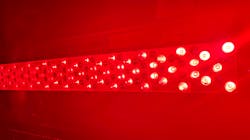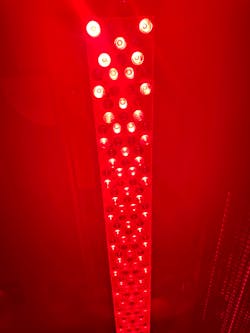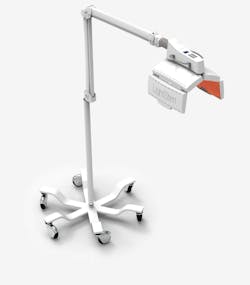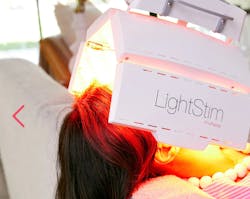Red light therapy: A comprehensive overview for dental professionals
Red light therapy (RLT) has been gaining in popularity among medical and dental professionals as a safe and effective treatment option that can help speed up recovery times for certain injuries or ailments. RLT, also called photobiomodulation or low-level light therapy, is the process of diffusing concentrated wavelengths of natural light into the skin/mucosal lining of the mouth to treat various ailments by improving the functioning of cells. It is a form of specialized treatment that uses wavelengths of red and near-infrared light to stimulate healing and repair processes within the body. Red and near-infrared light occupies the “long end” of the visible spectrum with wavelengths of 630–940 nm (figure 1). This article will outline what RLT is, how it works, its potential health benefits, and how to apply it within the dental profession.
What is red light therapy?
RLT is an “alternative” medical procedure that involves exposing the human body to specific wavelengths of light energy to stimulate three major healing processes within the body. First, when you expose your body to red and near-infrared light, the mitochondria, or the “powerhouse” organelles of your cells, soak it up and make more energy in the form of ATP (adenosine triphosphate) by activation of cytochrome oxidase C. By increasing the efficiency of the mitochondria using RLT, more ATP (the body’s energy currency) is made. With more energy, cells can function more efficiently and rejuvenate themselves. Second, RLT modulates reactive oxygen species leading to repair of DNA damage and antioxidation effects. Third, RLT causes the release of nitric oxide, a potent vasodilator leading to increased blood flow and tissue repair.
Red and near-infrared light is effective for use on the skin’s surface and penetrates up to two inches into the body, affecting the cells, tissues, blood, nerves, brain, and bone. Because of this, the energy generated by this type of light can help promote various antiaging biological processes such as the regeneration of cells, increased circulation, reduction in inflammation, and increased collagen production.
Red light therapy and health benefits
RLT triggers a reaction called hormesis. The term is derived from the Greek word hormàein, meaning “to excite” or “to set in motion.” The theory of adversity mimetics is that small doses of either toxins or stressors can have a beneficial effect on the body. In other words, what doesn’t kill you makes you stronger. Research shows that RLT exerts temporary mild oxidative stress on the mitochondria, which sends a signal to the cells to become stronger and activate its defense systems. This anti-inflammatory and antioxidant response ultimately increases the energy efficiency of the cells, making them more capable of energy production. By utilizing these wavelengths of light, different areas within the body—such as damaged tissue, blood vessels, and nerves that have been affected by injury or illness—can be targeted to reduce pain and accelerate recovery time.
How can red light therapy be used in dentistry?
Periodontal treatment
RLT has been used as an adjuvant during hygiene appointments to treat children with chronic gingivitis and improve outcomes.1 It has also been used in conjunction with scaling and root planing versus scaling and root planing alone to treat severe periodontitis. The treatment group that used light therapy had improved clinical outcomes compared with the control group.2 Similar studies using light therapy in conjunction with scaling and root planing all found improved outcomes when treating patients with chronic periodontal disease.3 Most studies agree that improved outcomes are generally the result of the light therapy being able to decrease bacterial burden and inflammatory markers as compared with conventional nonlight-based treatments.4 Light therapy has also been used to expedite the regeneration of hard and soft tissue in extraction sockets and periodontal defects; however, more controlled clinical trials are needed to support this use (figure 2).5
Endodontic treatment
Because light therapy has been shown to have a substantial antibacterial property, it has been used to improve outcomes when used as an adjuvant during root canal therapy.6 Light therapy has also been used successfully to decrease pain from root canal treatment and retreatment therapy.7 Other studies evaluating light therapy as compared with conventional endodontic treatments for pulpotomy suggest equivalency.8 The basic conclusion for light therapy when it comes to endodontic treatment suggests that this treatment can be considered a useful adjuvant and possible alternative for vital pulp therapy and human primary teeth.9
Treating oral ulcerations and mucositis
Laser and low-level light therapy to treat aphthous ulcers (canker sores) have been well documented in the literature. Light therapy has also been shown to decrease denture stomatitis and angular cheilitis via a fungicidal mechanism on Candida albicans.10 Other case studies suggest that light therapy can be used safely and effectively for the treatment of mucositis, dry mouth, and burning mouth syndrome caused by chemotherapy in patients undergoing cancer treatment.11 Finally, low-level light therapy has been used successfully to treat medication-related osteonecrosis lesions (MRONJ) in animal studies by expediting gingival wound healing.12
It is important for the dental profession to recognize that red/infrared light therapy has many therapeutic applications in the oral environment. Traditionally used in dermatology and skin care esthetics (figure 3), light therapy can be used in the dental office for periodontal, endodontic, and ulcerative oral treatments.
Editor’s note: This article originally appeared in Perio-Implant Advisory, a chairside resource for dentists and hygienists that focuses on periodontal- and implant-related issues. Read more articles and subscribe to the newsletter.
References
- Igić M, Kesić L, Apostolović M, Kostadinović L. [Low-level laser efficiency in the therapy of chronic gingivitis in children]. Vojnosanit Pregl. 2008;65(10):755-757. Serbian. doi:10.2298/vsp0810755i
- Giannelli M, Materassi F, Fossi T, Lorenzini L, Bani D. Treatment of severe periodontitis with a laser and light-emitting diode (LED) procedure adjunctive to scaling and root planing: a double-blind, randomized, single-center, split-mouth clinical trial investigating its efficacy and patient-reported outcomes at 1 year. Lasers Med Sci. 2018;33(5):991-1002. doi:10.1007/s10103-018-2441-9
- Malgikar S, Reddy SH, Sagar SV, Satyanarayana D, Reddy GV, Josephin JJ. Clinical effects of photodynamic and low-level laser therapies as an adjunct to scaling and root planing of chronic periodontitis: a split-mouth randomized controlled clinical trial. Indian J Dent Res. 2016;27(2):121-126. doi:10.4103/0970-9290.183130
- Pamuk F, Lütfioğlu M, Aydoğdu A, Koyuncuoglu CZ, Cifcibasi E, Badur OS. The effect of low-level laser therapy as an adjunct to non-surgical periodontal treatment on gingival crevicular fluid levels of transforming growth factor-beta 1, tissue plasminogen activator and plasminogen activator inhibitor 1 in smoking and non-smoking chronic periodontitis patients: a split-mouth, randomized control study. J Periodontal Res. 2017;52(5):872-882. doi:10.1111/jre.12457
- Nica DF, Heredea ER, Todea DCM. Alveolus soft and bone tissue regeneration after laser biomodulation - a histological study. Rom J Morphol Embryol. 2019;60(4):1269-1273.
- Asnaashari M, Mojahedi SM, Asadi Z, Azari-Marhabi S, Maleki A. A comparison of the antibacterial activity of the two methods of photodynamic therapy (using diode laser 810 nm and LED lamp 630 nm) against Enterococcus faecalis in extracted human anterior teeth. Photodiagnosis Photodyn Ther. 2016;13:233-237. doi:10.1016/j.pdpdt.2015.07.171
- Chen Y, Chen XL, Zou XL, Chen SZ, Zou J, Wang Y. Efficacy of low-level laser therapy in pain management after root canal treatment or retreatment: a systematic review. Lasers Med Sci. 2019;34(7):1305-1316. doi:10.1007/s10103-019-02793-6
- Alamoudi N, Nadhreen A, Sabbagh H, El Meligy O, Al Tuwirqi A, Elkhodary H. Clinical and radiographic success of low-level laser therapy compared with formocresol pulpotomy treatment in primary molars. Pediatr Dent. 2020;42(5):359-366.
- Fernandes AP, Lourenço Neto N, Teixeira Marques NC, et al. Clinical and radiographic outcomes of the use of low-level laser therapy in vital pulp of primary teeth. Int J Paediatr Dent. 2015;25(2):144-150. doi:10.1111/ipd.12115
- Maver-Biscanin M, Mravak-Stipetic M, Jerolimov V. Effect of low-level laser therapy on Candida albicans growth in patients with denture stomatitis. Photomed Laser Surg. 2005;23(3):328-332. doi:10.1089/pho.2005.23.328
- El Mobadder M, Farhat F, El Mobadder W, Nammour S. Photobiomodulation therapy in the treatment of oral mucositis, dysphagia, oral dryness, taste alteration, and burning mouth sensation due to cancer therapy: a case series. Int J Environ Res Public Health. 2019;16(22):4505. doi:10.3390/ijerph16224505
- Zheng Y, Dong X, Chen S, et al. Low-level laser therapy prevents medication-related osteonecrosis of the jaw-like lesions via IL-1RA-mediated primary gingival wound healing. BMC Oral Health. 2023;23(1):14. doi:10.1186/s12903-022-02678-1
About the Author

Scott Froum, DDS
Editorial Director
Scott Froum, DDS, a graduate of the State University of New York, Stony Brook School of Dental Medicine, is a periodontist in private practice at 1110 2nd Avenue, Suite 305, New York City, New York. He is the editorial director of Perio-Implant Advisory and serves on the editorial advisory board of Dental Economics. Dr. Froum, a diplomate of both the American Academy of Periodontology and the American Academy of Osseointegration, is a volunteer professor in the postgraduate periodontal program at SUNY Stony Brook School of Dental Medicine. He is a PhD candidate in the field of functional and integrative nutrition. Contact him through his website at drscottfroum.com or (212) 751-8530.




